Top 10 Reasons I’m Not Paleo

The paleo diet is the hottest fad diet since vegetarianism. If you’re not familiar with the movement, paleo folks eat a “paleolithic” or “caveman” diet of meat, more meat, and pretty much anything they can forage (berries, nuts and so forth). The only foods that are allowed are ones that were available prior to the dawn of agriculture 10,000 years ago.
If you’re following a paleo diet and it is working for you, more power to you. We can agree to disagree.
Here are my top 10 reasons why I’m not paleo.
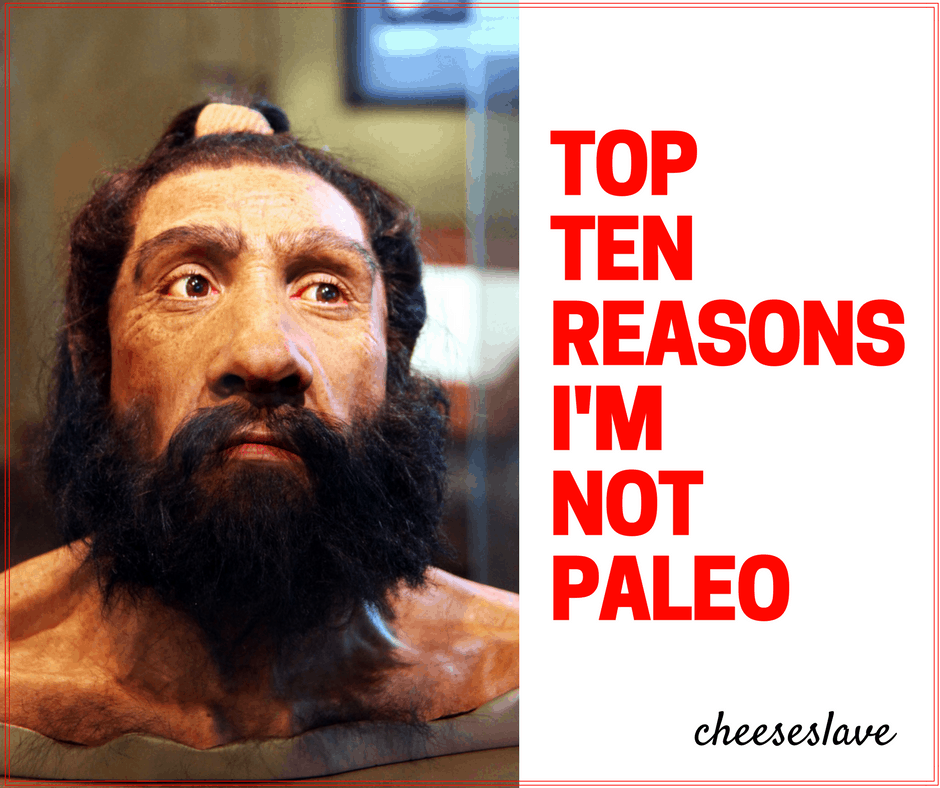
Top 10 Reasons I’m Not Paleo
1. I Really Like Cheese
Which is why I named this blog CHEESESLAVE. But cheese is verboten on the paleo diet.
Yes, I know some paleo people eat cheese, but many of them think that eating a chunk of cheddar is equivalent to making a pact with the devil. You see, according to their logic, cheese is a “neolithic” food, and therefore not paleolithic. At best, it’s considered a compromise food for most paleo folks.
It’s true, cheese is neolithic. And yet it has been a staple food among humans for over 10,000 years.
If that’s not “old” enough for you, how old is old enough? Homo habilis? Homo erectus?
I ask you, do we really need to go back 1 million years ago to eat a healthy diet?
And if so, why? Why do we need to go that far back? Are the health benefits of homo erectus that much better than those of say, someone living 100 or 200 or even 500 years ago?
Do we really need to throw the baby out with the bathwater and throw out all dairy (and the foods of domesticated animals) and all grains? If so, why? Is there evidence for that?
Sorry, I’m going into Unfrozen Caveman Lawyer here…. 🙂
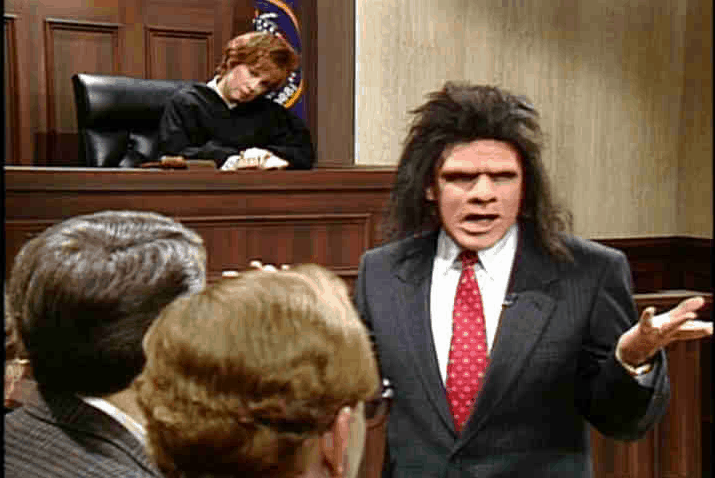
Phil Hartman as Unfrozen Caveman Lawyer (Click the link to watch the video — hilarious!)
But honestly, if you’ve been eating paleo for any length of time, don’t you miss grilled cheese sandwiches? Quesadillas? Pizza?
Speaking of pizza and grilled cheese sandwiches…
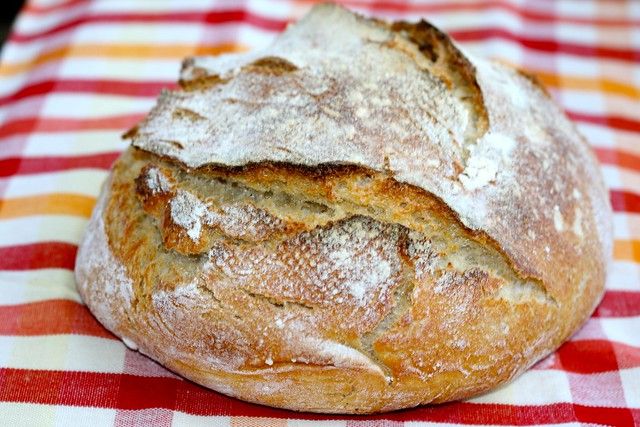
2. I Really Like Bread
Crusty sourdough with lots of butter. Hearty brown German sunflower bread. Croissants. (Yes, croissants. They may be made with white flour, which is very low on the nutrient-density scale. But did you know they are almost 40% butter?)
And is bread really that bad for you? How can it be, when humans around the world have been thriving on it as a staple in their diet for over 10,000 years (and possibly up to 50,000 years)?
Is the modern epidemic of “gluten intolerance” really caused by eating wheat? Or is it possible that something else is causing gluten intolerance?
There is a theory that antibiotic drugs cause an imbalance of gut flora and cause prevent the digestive tract from secreting enzymes that enable us to break down complex proteins such as gluten. Sounds a lot more plausible than the idea that wheat suddenly started causing gluten intolerance out of nowhere.
I’m sure I’ll get lots of comments about [easyazon-link asin=”1609611543″ locale=”us”]Wheat Belly[/easyazon-link] and the theory of “modern” wheat. Of course, I think that is a load of hogwash. Humans have been cross-breeding crops since the dawn of agriculture. And antibiotics are a LOT more harmful than modern wheat ever will be.
I will write a more detailed post about the flaws in the modern wheat theory at a later date when I finish reading the book.
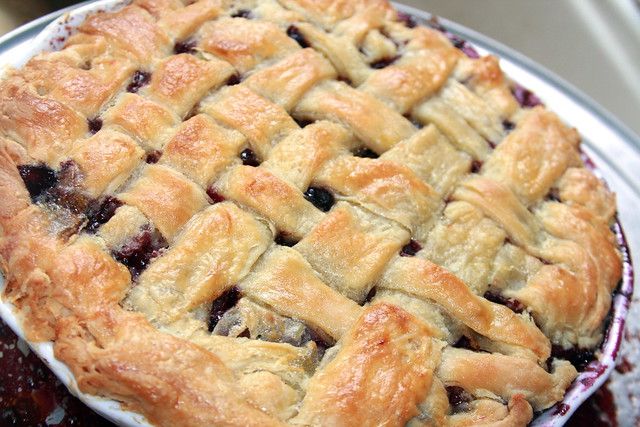
3. I Really Like Cookies. And Cake. And Pies.
Hey, I understand, you’re on the GAPS diet, you can’t eat grains. That’s cool. I totally respect that. I gave up gluten for 2 years when I was healing my gut in my 20s. (And yes, I did overcome gluten intolerance.)
But would I go without grains for life? No way. I don’t eat sweets every day, but I do enjoy them often. And of course, I do try to use unrefined sweeteners.
And what is wrong with pies exactly? Oh sure, there’s some white flour in the crust. But it’s also loaded with nutritious butter and lard. Can this really be so bad?
And do you really need to eat like Australopithecus Afarensis to feel like you’re eating a healthy diet? Have you seen a picture of Australopithecus Afarensis lately?
Here you go:
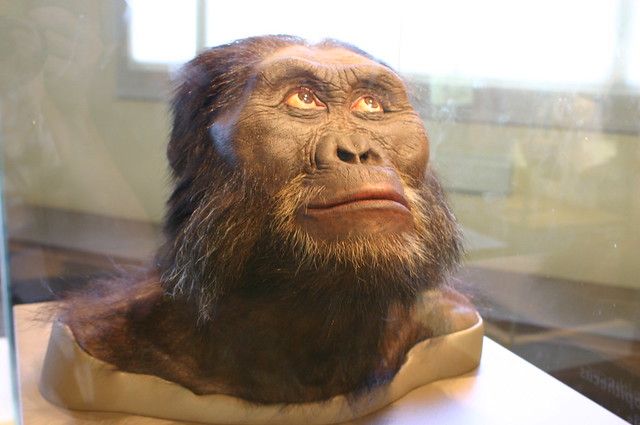
Why not just go back one hundred years? Or even two hundred? That still constitutes a traditional diet. Heck, we could evren go back to the middle ages.
And you know what they ate in the middle ages? They ate pies.
4. Paleo is Low Carb
By default. And low carb messed me up. See my post: Why I Ditched Low Carb.
Be sure to read the bit about Chris Masterjohn, Dr. Weston Price, the people living near the Arctic Circle and fertility. That was key for me, and really opened my eyes. If you have to eat thyroid gland in order to reproduce, your low carb diet may not be working so well.
Hey, if you’re living in a place where you don’t have any access to carbs (i.e. the North Pole), then, yeah, it makes sense to go kill a bunch of moose and hand out the thyroid glands to the young people who want to have babies. But if you have ready access to carbs, such as potatoes and bread and rice, why not eat them?
And by the way, the Weston A. Price Foundation diet is not low carb. Dr. Price never recommended a low carb diet. There were some cultures he studied who ate low carb, but many others who did not. I’ll be writing a post about that soon.
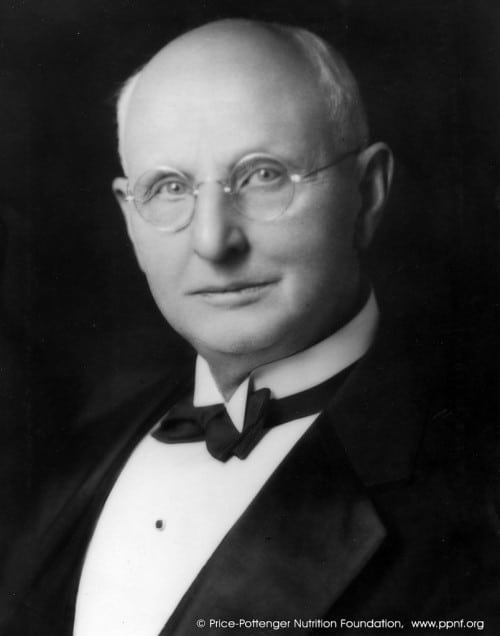
5. The Paleo Diet is Too Restrictive
We live in a world dominated by pizza, nachos and chocolate chip cookies. Are you really going to tell your kids they can’t have these things — ever — because (ahem) “they’re not paleo”?
Why not, instead, learn how to make healthy versions of nachos and chocolate chip cookies and pizza (recipe coming soon)?
If you raise your children to be logical and good critical thinkers (and I hope you do), I don’t think they’ll fall for your flawed logic that a paleo is superior just because it is paleo. (See #6 and #7 below.)
I understand that we want our children to eat a nutritious diet. And there is nothing wrong with promoting nutritious foods and working hard to get our children to eat them. Obviously I am a proponent of that — otherwise, I would have never started this blog, and kept it going for almost five years.
I always tell my daughter she can’t have candy or cookies before dinner because they are foods that won’t make her grow big and strong. However, she’s allowed dessert after dinner. I try to serve nutrient-dense desserts like crème brûlée or ice cream made with grass-fed cream and egg yolks, chock-full of fat-soluble activators, vitamins A, D and K2.
I’d never tell her she can’t eat a cookie because “it’s not paleo”. That’s just bad logic.
And around here, we follow the 80/20 rule. A cookie here and there won’t kill you if you are eating a nutritious diet most of the time.
6. Paleo is Not Scalable
There’s a reason the hunters and gathers died out. Nothing against hunter-gatherers, but they were all almost completely wiped out by people who ate cheese and bread.
Why? How? Want the evidence? Read Jared Diamond’s fascinating book, Guns, Germs and Steel.
In the book, Diamond explains that there are advantages to learning how to domesticate animals — especially big herbivores such as goats, cows, horses and sheep. You can use them to plow fields faster. And they can provide you with high-protein, nutrient-dense foods such as milk, butter and cheese.
And there are benefits to growing grains, which will store for very long periods of time. If you’ve got a silo of grain, and a cow that gives you milk every day, you no longer have to spend your days hunting and foraging and scheming how you’re going to get your next meal, you have more time to do things like invent new kinds of technology. Like steel weapons, guns — and iPads.
Diamond tells an amazing story in Guns, Germs and Steel about the Spanish conquest of the Peruvian Inca. On November 15th 1532, 168 Spanish conquistadors showed up in the holy city of Cajamarca, Peru, where they found 80,000 Peruvian soldiers. Although seriously outnumbered, 168 Spaniards slaughtered over 7,000 Inca warriors within 24 hours.
![2[LA]B](https://www.annmariemichaels.com/content/images/wp-content/uploads/2012/06/2LAB-1024x695.jpg)
How did this happen? (1) The Spaniards had horses and the Peruvians had no domesticated animals other than llamas, which could not be ridden. Soldiers on horseback had a distinct advantage over soldiers on foot. (2) The Spaniards had steel swords and guns. The Inca were unarmed.
While guns and steel killed many native people (as the above story illustrates), it was germs that were responsible for the genocide of the Indians:
European farmers, rearing cattle, pigs, sheep, goats, horses and donkeys, lived in close proximity with their animals — breathing, eating and drinking animal germs.
Native Americans had no domesticated animals, and when they were exposed to these germs from livestock, they perished in great numbers.
Is this to say that killing innocent people and taking their land is a good thing? No, Diamond is not defending colonialism; nor am I. He is simply making the point that there are very few hunter-gatherer tribes left on the planet because the world has changed and technology has advanced.
When we stop having to worry so much about how to find food, we are able to advance as a species.
Because hunting is so unpredictable, traditional societies have usually relied more on gathering. In this part of Papua New Guinea, the gathering is done by women. An important source of food here [in Papua New Guinea] is wild sago. By stripping a sago tree they can get to the pulp at the centre, which can be turned into dough and then cooked. Although it’s physically harder work, gathering is generally a more productive way of finding food than hunting. But it still doesn’t provide enough calories to support a large population.
Jared Diamond: This jungle around us, you might think it’s a cornucopia, but it isn’t. Most of these trees in the jungle don’t yield, don’t give us anything edible. There were just a few sago trees, and the rest of these trees don’t yield anything that we could eat.
And then sago itself has got limitations — one tree yields only maybe about 70 pounds of sago. It takes them three or four days to process that tree, so it’s a lot of work really for not a great deal of food, plus the sago starch is low on protein, and also the sago can’t be stored for a long time. And that’s why hunter/gatherer populations are so sparse. If you want to feed a lot of people, you’ve got to find a different food supply, you’ve got to find a really productive environment, and it’s not going to be a sago swamp. (Source)
7. Paleo is Based on Fantasy
The paleo diet is fundamentally flawed. It’s a diet based on misinformation about the past and the present. Paleo adherents believe that the hunter-gatherer lifestyle is somehow superior to that of the sedentary agriculturalist. It is a romantic ideal based on fantasy, not reality.
The reality is that living as a hunter-gatherer is not an easy life, and it was not a lifestyle people chose because they thought it was cool or better. Hunter-gatherers did/do not have access to domesticated animals and did not have the ability to grow crops. I find it very hard to believe that if they had cows or sheep that they would not have found a way to start milking them.
Why go forage for a meal or hunt for a wild animal when you can keep a cow who will give you milk every day with a lot less effort?
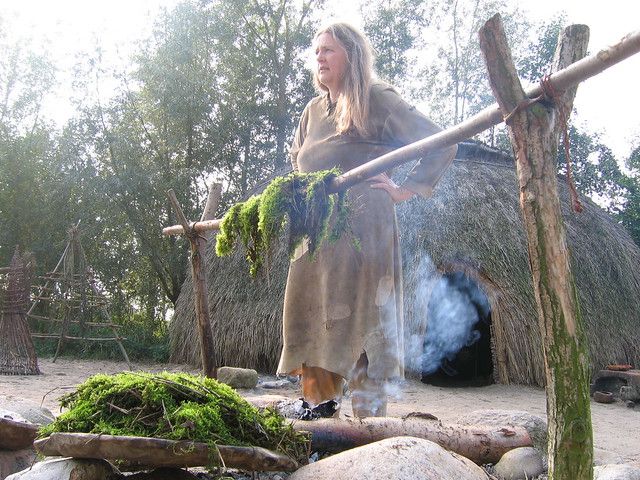
I guarantee you, if you were living in the wild, subsisting on sago that takes 3-4 days to process and is very low in protein, and someone brought you a cow that would give you milk every day, or showed you how to cultivate honey from a bee hive, you would jump at the chance.
According to Jared Diamond in [easyazon-link asin=”1565115147″ locale=”us”]Guns, Germs and Steel[/easyazon-link], cannibalism may have arisen in New Guinea due to the scarcity of sources of protein. The traditional crops, taro and sweet potato, are low in protein compared to wheat and pulses, and the only edible animals available were small or unappetizing, such as mice, spiders, and frogs. Cannibalism led to the spread of Kuru disease, affecting the brain, similar to Creutzfeldt-Jakob disease, prompting the Australian administration to outlaw the practice in 1959. (Source)
I’m not saying that if you become a hunter-gather, you will be driven to cannibalism. I’m just saying hunting and gathering isn’t all it’s cracked up to be. And maybe grains and legumes aren’t so bad after all. Balance is a good thing.
8. Paleo is Impractical
Is anyone really expecting people to get out and hunt for their breakfast? How about foraging? Are we expected to forage for our all of our meals? On top of working 9 hours per day plus taking care of the kids and getting them to soccer practice?
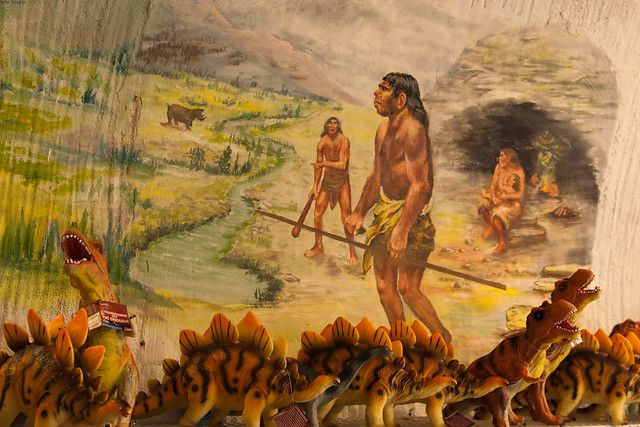
So how do we “do” paleo in the real world? Buy grass-fed beef and organic arugula from the upscale health food store? And is this really practical?
OK, I can see storing loads of meat and fish in the deep freeze. I do that.
But how do we stay on top of all the fresh veggies? We can’t serve beans or grains — so we must keep vast amounts of fresh veggies in the fridge and freezer.
If you ask me, it’s exhausting. Especially if you have a large family.
Now, I’m not knocking the GAPS Diet for those who really need it. If I had an autistic child and s/he was doing better on GAPS (and I’ve heard so many stories from moms whose kids have VASTLY improved on GAPS), you’d better believe I’d follow GAPS.
But GAPS is a temporary diet for people who need healing. It’s not, in my opinion, a lifelong diet. Dr. Campbell-McBride includes instructions in her book, Gut and Psychology Syndrome: Natural Treatment for Autism, Dyspraxia, A.D.D., Dyslexia, A.D.H.D., Depression, Schizophrenia, for how to reintroduce dairy products, legumes, and whole grains.
9. Paleo is Expensive
I can make a one-pound loaf of whole wheat sourdough bread for about 50 cents to $1. Compare that to anywhere from $4-12 for a pound of ground beef.
Dried beans cost around 25 to 50 cents after they are soaked and cooked.
If you’re in your twenties and you have a lot of disposable income, then sure, paleo is no problem.
But for a single mom who is struggling to put food on the table to feed her three kids, it’s another story. If she’s on the paleo diet, she’s not allowed to stretch meals with beans and rice and bread. Because it’s “not paleo”.
I’ve met plenty of people from Honduras and Mexico and Guatemala who grew up on rice and beans (and plenty of good fats and organ meats) who had no cavities or degenerative disease. Same goes for people from Russia and Slovakia.
Not to mention the healthy cultures that Dr. Weston A. Price studied. The Swiss who ate 50% of their diet as sourdough rye bread. Or the Scots who ate 50% of their diet as soaked oats. They were vibrantly healthy eating whole grains.
10. The Paleo Diet is a Waste of Time and Energy
I often see Paleo people on Facebook or Paleo Hacks arguing over whether or not honey is paleo. They proudly pronounce their disdain for milk and other dairy products, as “neolithic foods”.
I ask you, why do people sit around arguing about whether or not honey is paleo? Why not just go buy some honey at the grocery store? Or, better yet, a farmer’s market?
Why not just feed yourself with what is available, and then get on to more important things, such as inventing alternative energy sources or curing cancer?
Subscribing to an extremely rigid diet based on a load of misinformation and made-up ideas and sitting around defending it seems like a giant waste of time, especially when there are so many more interesting, valuable, and important things to be doing in the world.
I’m not recommending that we go out and buy boxes of Frosted Flakes. But what is wrong with soaked granola made with raw, local honey? My point is that there is a middle ground. We don’t need to travel back thousands of years to be healthy.
Want More?
If you enjoyed this post, you will enjoy this e-book by Matt Stone: 12 Paleo Myths. I read and loved it. I’ll be posting a review soon.
Update: I’m a big advocate of freedom of speech and believe in lively debate and sharing of opinions. That said, name-calling, fighting, and general nastiness will no longer be tolerated. I don’t have a comments policy posted anywhere on this blog, so I’m posting it now. Any comments that are disrespectful, rude, and/or contain foul language will be deleted as spam. If you get enough spam comments, your comments will no longer appear.
Pin This Post
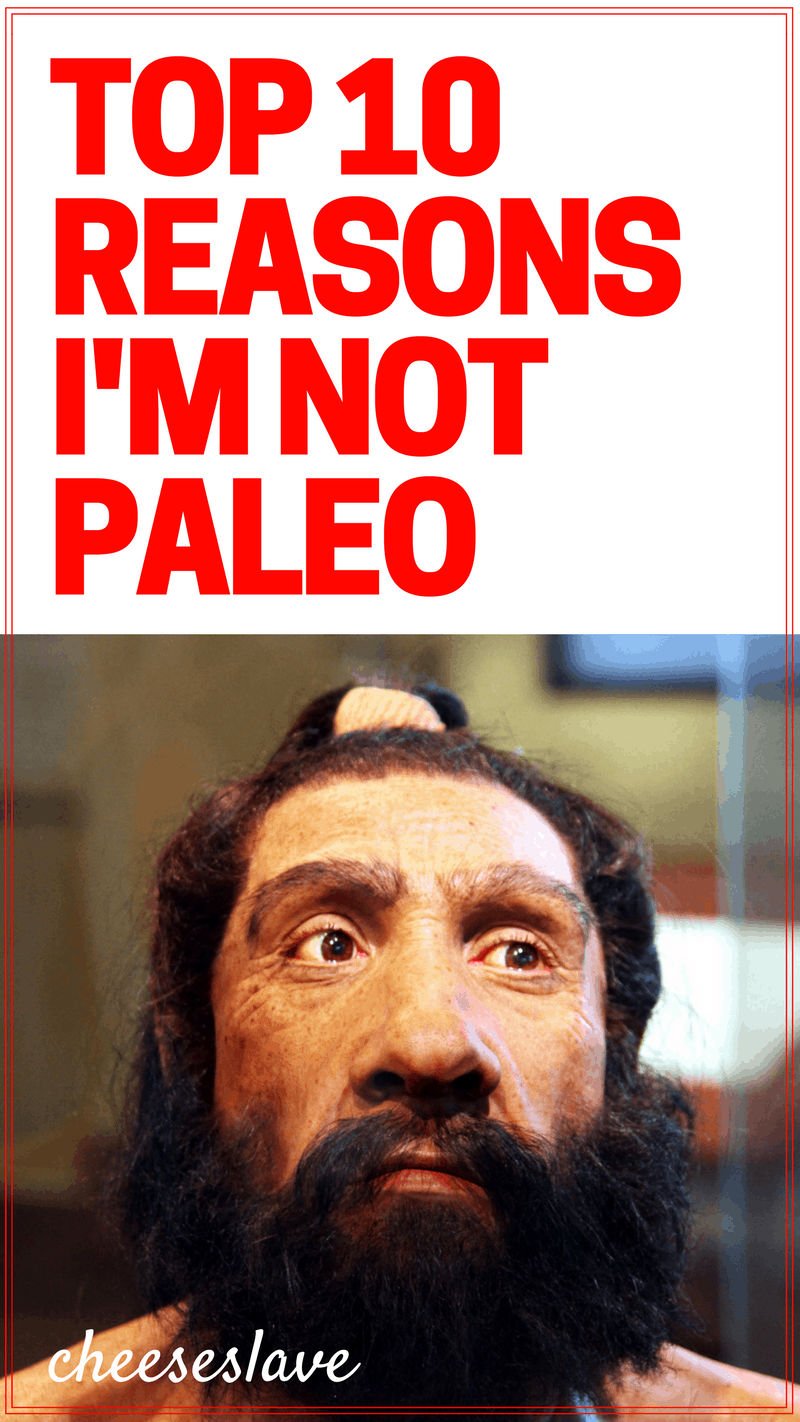

Comments ()